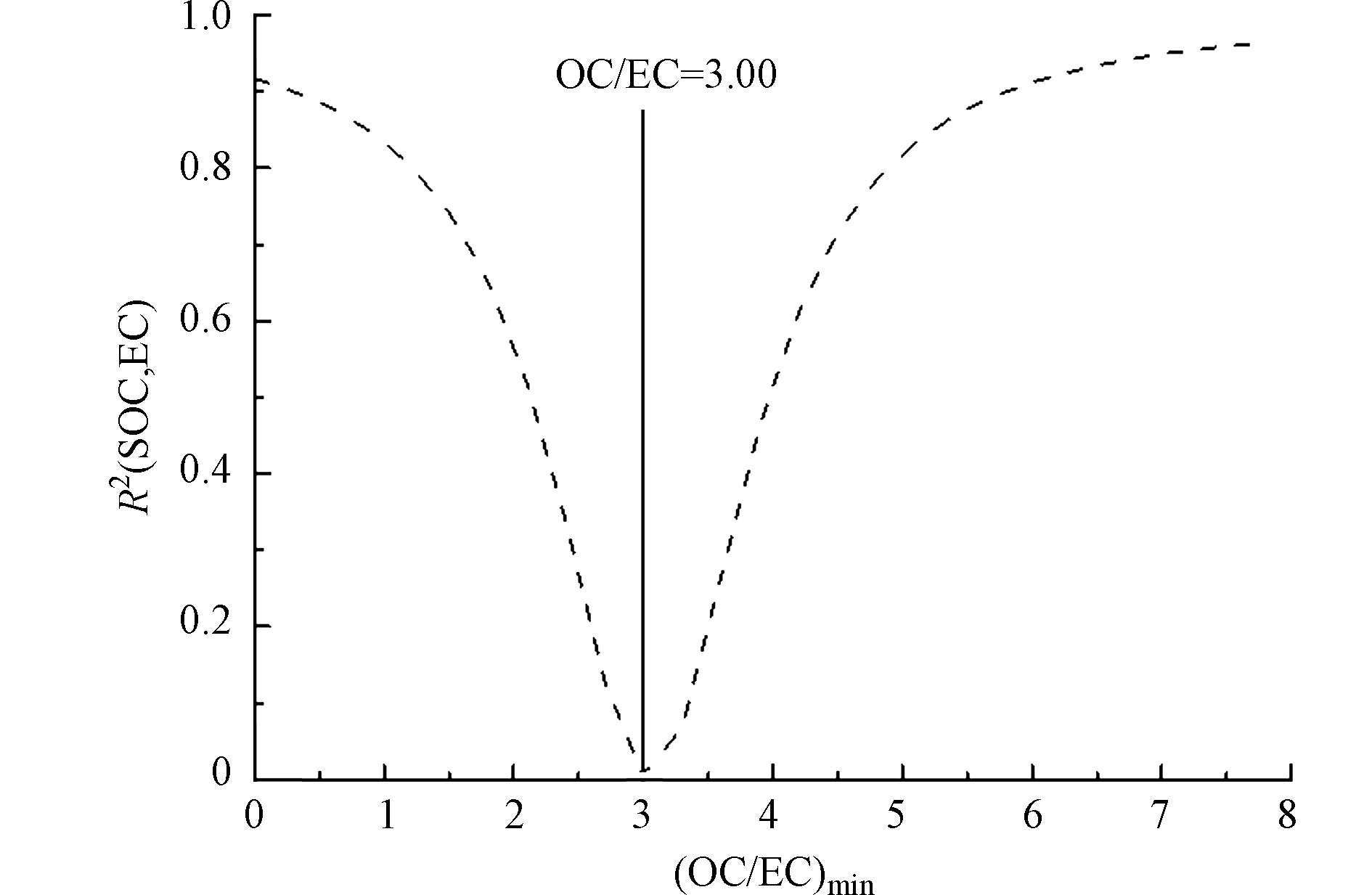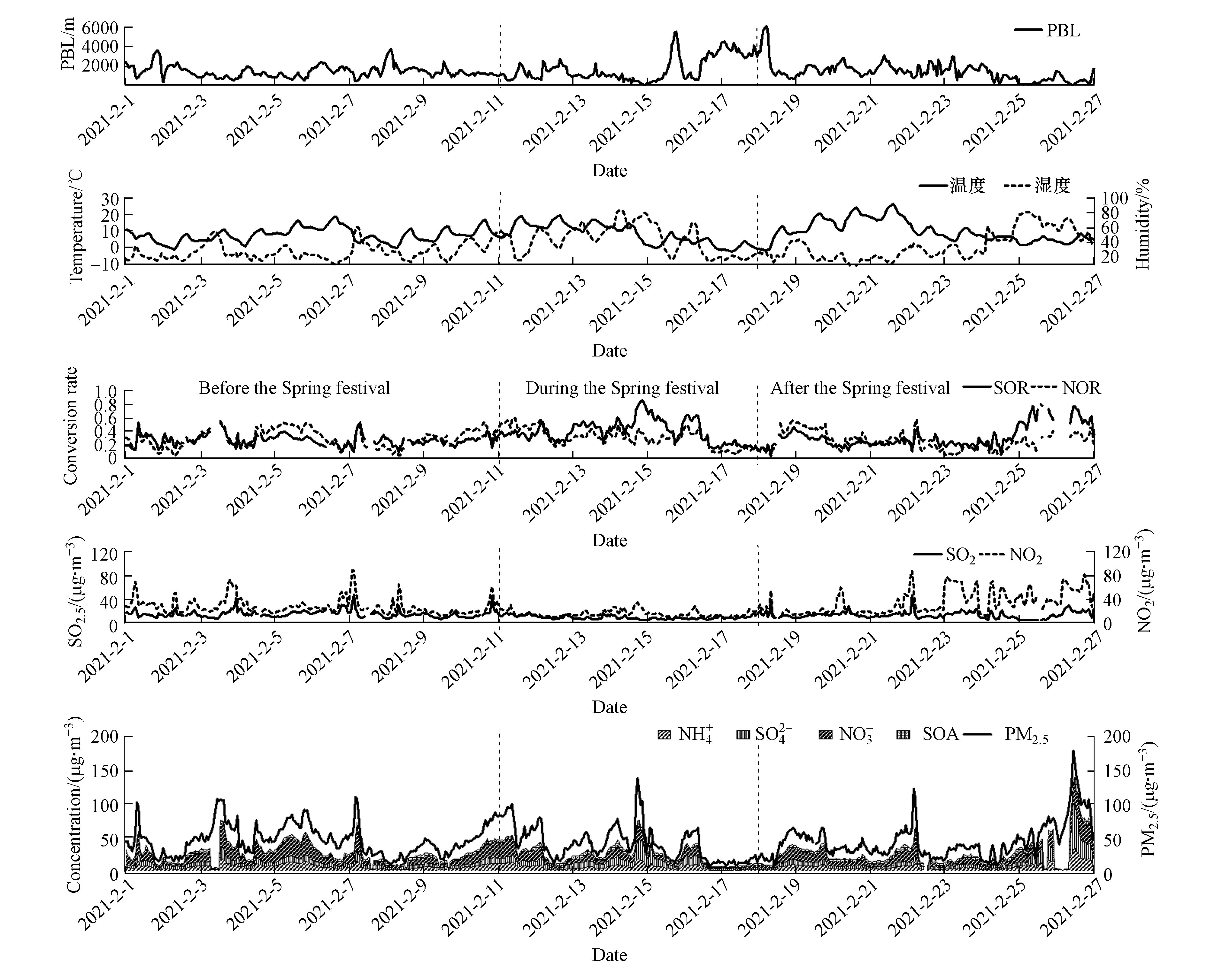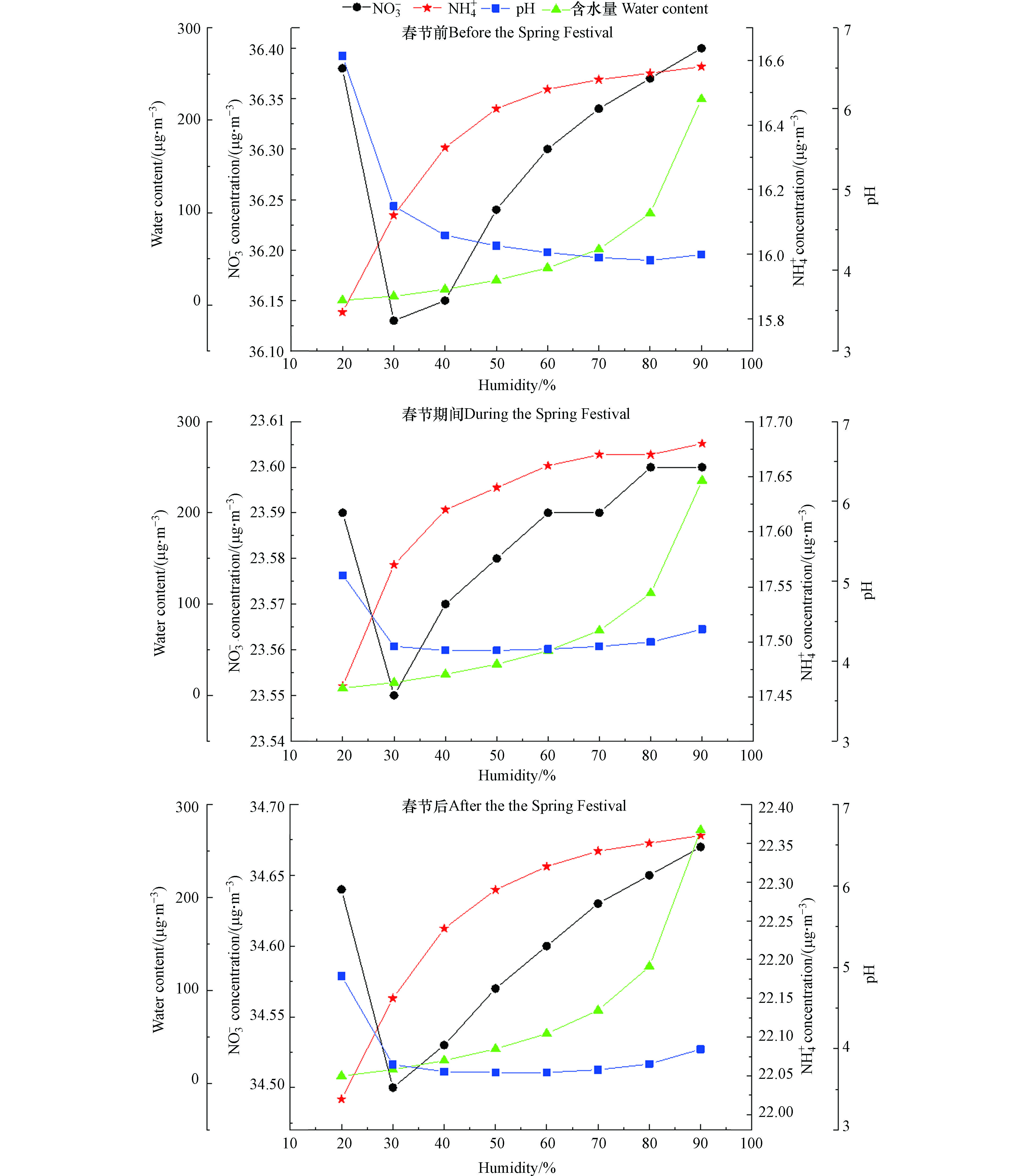-
大气细颗粒物PM2.5 [1]是影响环境空气质量的主要污染物,细颗粒物污染不仅能降低大气能见度[2],而且对人类的健康也具有重要影响[3-6],如果长期暴露在其中会造成肺-呼吸系统和心脑血管疾病,甚至死亡[7-9]。大量研究证明,二次组分(
NO−3 、SO2−4 、NH+4 和SOA)是大气细颗粒物的重要组成成分,含量约占PM2.5的30%—70%,二次组分严重影响空气质量,且更易进入呼吸系统,对人们的健康影响更大[10]。春节是中国的传统佳节,春节期间因市民活动密集、车流量增加以及燃放烟花爆竹等因素都会造成对空气质量的影响,尤其是2021年春节爆发了二次新冠疫情。因此,研究2021年春节PM2.5中二次组分污染特征及其影响效应对于区域空气环境质量及人类健康具有重要的意义。新冠疫情爆发以来,有学者对疫情期间城市空气中PM2.5组分污染特征及成因进行了研究,并调研了气象条件和污染排放对其的影响。纪源等[11]分析了南京市疫情期间PM2.5中碳质组分污染特征,王申博[12]等分析了河南省疫情和春节影响情景下PM2.5组分特征。黄炯丽等[13]分析了南宁市疫情下一次大气PM2.5污染成因,张红等[14]分析了安徽省春节和疫情影响下PM2.5浓度变化成因。朱媛媛等[15]评估了疫情期间“2+26”城市污染减排成效,逯世泽等[16]研究了武汉市新冠肺炎疫情期间气象条件和污染源排放变化对PM2.5的影响。现有研究对大中型城市疫情期间PM2.5污染特征及其健康风险评价已有积累,但对于疫情常态化管控下PM2.5中二次组分的污染特征及其影响因素的研究还需进一步跟进。
济南市是“2+26”京津冀大气污染传输通道城市之一,是以煤炭为主要能源的老工业城市[17]。2020年春节(1月25日)前后新冠肺炎席卷中国,国家实施“不拜年不聚会不串门”政策,机动车大量减少,工地停工,城市烟花爆竹燃放得到控制[18]。2021年春节期间仍实施新冠肺炎常态化管控,国家实施“就地过年”政策,虽跨省出行不多,但省内出行还是绿色通道,尤其是春节后复工复产,疫情期间人为源污染排放量变化会对城市PM2.5中二次组分产生显著影响。因此本研究对疫情常态化管控下济南市2021春节前后PM2.5中二次组分污染特征进行分析,结合在线数据,从PM2.5中
NO−3 、SO2−4 、NH+4 和SOA时间变化规律、二次无机组分与气态前体物的气-粒分配、PM2.5中二次组分的影响因素等多角度分析,对于济南市PM2.5中二次组分综合治理提供技术支持。 -
监测点位位于山东省济南市区市监测站(东经116°59′2″、北纬36°36′43″),包括环境空气自动监测设备(位于距离地面约15 m楼顶)和组分监测车(车载组分监测车采样高度距离地面7 m),周边主要污染源包括居民区、餐饮业和道路交通等,无大型工业企业和工地。监测时间为2020年1月14日—2月9日(春节前:1月14日—23日,春节期间:1月24日—30日,春节后:1月31日—2月9日)和2021年2月1日—27日(春节前:2月1日—10日,春节期间:2月11日—17日,春节后:2月18日—27日),时间分辨率为1 h。
-
采用气溶胶有机碳/元素碳分析仪(先河环保科技有限公司,Model 4)和气溶胶在线离子色谱仪(台湾张嘉有限公司,S-611 C)分别进行碳组分(OC,EC)、离子(
NO−3 、SO2−4 、NH+4 、Na+、Ca2+、K+和Mg2+)以及NH3、HNO3、HNO2和HCl等组分的在线快速分析,这些组分监测设备均安装于1台组分监测车上,组分监测车位于市监测站点所在的庭院内空地上;常规污染物(PM2.5、NO2、SO2、O3和NO等)和气象参数(温度、相对湿度和风速等)均来自市监测站点位国家环境空气自动在线监测数据,大气边界层高度PBL由环境空气站点楼顶激光雷达EV-LIDAR同步监测得到,时间分辨率为1 h。 -
气溶胶有机碳/元素碳分析仪采用浓度为2.1 μg·μL−1的标准蔗糖溶液,分别注射2、4、6、8、10 μL的溶液制作蔗糖标准曲线,每季度做1次,相关系数R2≥0.997;当仪器更换核心部件后,重新进行标准曲线校准。每周用10 μL的2.1 μg·μL−1的标准蔗糖溶液进行单点标定,误差控制在±10%以内。每月进行1次采样流量校核,使用经过计量检定的标准流量计对设备流量进行检查,如流量偏差超过±15%,则进行校准。
气溶胶在线离子色谱仪采用外标法制作标准曲线,标准溶液浓度分别为0.005、0.01、0.02、0.05、0.1、0.2、0.5、1 mg·L−1,每月绘制一次校准曲线,所有目标物相关系数R2≥0.995。当仪器更换定量环、色谱柱、抑制器等核心部件后,重新进行标准曲线校准。每2周使用去离子水(≥18 MΩ.cm)检查仪器基线与空白响应情况,如任一目标物响应高于方法检出限,及时排查后重新进行测试。每周进行一次标准曲线中间浓度点核查,所有目标物核查结果与标准曲线相应点的理论浓度值相对误差应小于±10%,否则重新进行标准曲线校准。每月进行一次采样流量核查,使用经过计量检定的标准流量计对设备流量进行检查,如流量偏差超过±5%,则进行校准。
-
为了分析二次有机气溶胶(SOA)在疫情常态化管控下济南市春节前后的特征,本文对SOA采用间接计算法,计算公式[19-20]如下:
式中,SOC为二次有机碳的质量浓度,μg·m−3,K为经验系数,根据文献[19-20]中的郑州市和济南市均属于北方省会城市,且冬季颗粒物污染和气象条件变化大致相近,故选1.4;(OC/EC)min为采样期间OC/EC的最小值,本研究采用最小相关系数法[21](MRS)来确定(OC/EC)min,MRS通过计算1组假设的(OC/EC) min和SOC值,得到R2(SOC,EC),产生最小R2(SOC,EC)的( OC/EC) min即为实际的( OC/EC) min,由图1可见,(OC/EC)min=3.00。
-
研究发现,SOR和NOR可以表示SO2和NO2向
SO2−4 和NO−3 的转化率,SOR和NOR值越大,表示SO2和NO2生成SO2−4 和NO−3 越多,计算公式[22]如下:式中,ρ(SO2)和ρ(NO2)分别为SO2和NO2的浓度,μg·m−3,ρ(
SO2−4 )和ρ(NO−3 )分别为SO2−4 和NO−3 的浓度,μg·m−3。 -
ISORROPIA-Ⅱ模型是无机热动力学平衡模型,模型假设气溶胶体系可以达到热动力学平衡,根据输入的PM2.5中Na+、
SO2−4 、Ca2+、K+、Mg2+、THNO3(NO−3 , HNO3气体)、TNH3(NH+4 , NH3气体)、THCl(Cl−, HCl气体)、湿度(RH)和温度(T)数据,对输入的数据重新进行气粒分配,使整个体系能量最低,然后输出不同相态化学组分的浓度和液相的水含量,根据气溶胶含水量和液相的H+浓度计算气溶胶的pH,其公式[23]如下:式中,H+air为气溶胶中液相H+浓度,μg·m−3; ALW为气溶胶水浓度,μg·m−3。
ISORROPIA模型的输入数据均来自市监测站组分监测车和环境空气自动在线监测的小时值数据。
-
选取济南市疫情常态化管控春节前后2021年2月1日—2月27日进行在线监测,春节前和春节后均为10 d,春节期间为7 d,对2021年和2020年春节前后PM2.5和二次组分质量浓度的均值进行统计分析见表1,气象条件见表2。
由表1可见,2021年春节前后(春节前、春节期间和春节后)PM2.5和二次组分质量浓度均低于2020年。2021年春节前后ρ(
NO−3 )、ρ(SO2−4 )、ρ(NH+4 )和ρ(SOA)平均值分别为(10.78±7.50)、(6.78±6.32)、(6.26±4.33)、(3.61±1.26) μg·m−3,浓度与去年春节前后同比分别下降53.09%、58.32%、51.17%和61.84%,其在PM2.5中的占比分别为24.47%、15.39%、14.21%和8.20%,其中二次无机组分(NO−3 、SO2−4 、NH+4 之和)在PM2.5中的占比为54.07%,说明PM2.5污染主要与二次组分含量较高有关。春节前ρ(NO−3 )和ρ(NH+4 )均较大,浓度分别为12.48 μg·m−3和6.61 μg·m−3,可能与春节前返乡回家车流量增多有关[24]。春节期间ρ(SO2−4 )最大,浓度为7.56 μg·m−3,主要与春节期间湿度增大,H2SO4蒸汽压较低易转化为硫酸盐和春节期间周边农村地区居民居家取暖有关;另外与春节前和春节后相比,春节期间ρ(NO−3 )明显降低,且NOy(反应性总氮氧化物)、NO和DIF(NOy与NO差值)均较低,主要受春节期间机动车大幅减少影响[25](图2)。2021年春节前后ρ(PM2.5)平均值为 (44.05±24.94) μg·m−3,明显低于GB 3095-2012《环境空气质量标准》二级标准限值(75 μg·m−3)[26],与2020年春节前后相比,改善了113.42%,说明2021年济南市春节前后疫情常态化管控、禁止燃放烟花等政策的实施和温度较高、湿度较小、PBL较高等气象条件较好对环境空气质量改善具有很大贡献。 -
对疫情常态化管控下的济南市PM2.5二次组分、气态污染物及气象因素进行分析,整个春节前后二次组分的逐时浓度变化如图3所示。2021年春节前后ρ(
NO−3 )、ρ(SO2−4 )、ρ(NH+4 )、ρ(SOA)和ρ(PM2.5)变化规律基本一致,说明PM2.5中含有大量气态污染物二次转化后生成的组分,ρ(NO−3 )在PM2.5中的占比均最大,其次为ρ(SO2−4 )和ρ(NH+4 ),ρ(SOA) 在PM2.5中的占比最小,这一变化趋势主要是整个春节NO2浓度较高且NOR普遍高于0.1, NO2向NO−3 转化增多造成[27]。春节前、春节期间和春节后PM2.5浓度均出现峰值,春节前,2月7日4点最大峰值浓度为110.00 μg·m−3;春节期间,2月14日18点最大峰值浓度为137.70 μg·m−3;春节后,2月26日11点最大峰值浓度为178.90 μg·m−3,根据这三日的PM2.5浓度和GB3095-2012《环境空气质量标准》中PM2.5二级浓度日均标准(75 μg·m−3)判断,2月7日、14日和26日济南市大气细颗粒物污染较为严重,这三日均为微风,空气湿度大,PBL(大气边界层)较低,这些气象条件不利于大气中颗粒物的扩散,使得颗粒物大量积聚造成污染。整个春节前后二次组分的小时浓度变化如图4所示,春节前和春节后ρ(PM2.5)在0—23时均较高,而春节期间仅0—9时和18—23时浓度较高,10—17时浓度较低,主要由于春节期间白天人为活动相对减少、机动车、建筑工地等排放源减少,且湿度较低和大气边界层较高利于污染物的扩散。春节期间PM2.5中硫酸盐、硝酸盐、铵盐和PM2.5变化规律基本一致,说明春节期间PM2.5浓度主要受气态污染物的二次转化影响[22]。春节期间除11—16时外,其他时段硫酸盐浓度均高于春节前,主要是由于春节期间夜间湿度较大,混合层高度较低,促进了SO2向硫酸盐的转化。
-
分析济南市疫情常态化管控春节前后细颗粒物二次组分和气态前体物的相关系数,结果如表3所示。由表3可知,细颗粒物二次组分ρ(
NH+4 )与ρ(NO−3 )、ρ(SO2−4 )均显著相关(r>0.8,p<0.01),相关性系数分别为0.910和0.856,说明三者可能经历了相似的累积和转化过程。ρ(NO−3 )和ρ(HNO3)、ρ(NO)和ρ(NO2)均显著相关,相关系数分别为0.544和0.552,说明它们可以相互转化。过剩NH3指数[28](FN=[NH3]+[
NH+4 ]-2[SO2−4 ]-[NO−3 ]-[HNO3],均为摩尔浓度)可以用来判别大气气溶胶中NO−3 在形成过程中是受HNO3影响还是受NH3的影响。当过剩NH3指数<0时,表示NO−3 气溶胶在形成过程中主要受NH3的限制;当过剩NH3指数>0时,表示NO−3 气溶胶在形成过程中主要受HNO3的限制。对济南市春节前后过剩NH3指数进行计算,春节前、春节期间和春节后过剩NH3指数分别为0.55、0.66、0.69,均大于0,说明疫情常态化管控下的济南春节前后NO−3 气溶胶在形成过程中主要受NNO3的限制。研究发现,
NO−3 和NH+4 在不同SO2−4 水平下摩尔浓度的相对变化反映NO−3 的生成机制,常用[NO−3 ]/[SO2−4 ]和[NH+4 ]/[SO2−4 ]的线性方程与x轴的截距来表示NH4NO3形成机制[29],春节前后[NO−3 ]/[SO2−4 ]和[NH+4 ]/[SO2−4 ]的线性回归方程如图5所示,[NO−3 ]/[SO2−4 ]和[NH+4 ]/[SO2−4 ]均显著相关,相关系数R2分别为0.97、0.91和0.96。大气中的NH3能与气相H2SO4、HNO3和HCl等酸性气体发生化学反应生成颗粒态的(NH4)2SO4、NH4HSO4、NH4NO3和NH4Cl [30],但是由于H2SO4的蒸汽压较低,NH3首先与酸性气体中的H2SO4反应,剩余的NH3再与HNO3和HCl反应[31]。有研究表明当[NH+4 ]/[SO2−4 ]小于0.50时,生成少量NH4HSO4; 当比值介于0.50—1.25之间时,主要生成NH4HSO4; 当比值介于1.25—2.00时,NH4HSO4和(NH4)2SO4共存; 当比值大于2.00时,大量(NH4)2SO4生成。由图5回归方程y=0.69x−1.20、y=0.60x−0.76和y=0.74x−1.30计算得出直线与x轴的截距分别为1.74、1.27和1.76(介于1.25—2.00),可知疫情常态化管控下济南市春节前后PM2.5中NH4HSO4和(NH4)2SO4共存,NH4NO3的形成与过量的NH+4 有关,过量NH+4 计算公式[28]如下:式中,[
NH+4 ]和[SO2−4 ]分别为NH+4 和SO2−4 的摩尔浓度,μmol·m−3。对2021年疫情常态化管控春节前后[
NH+4 ]Excess和[NO−3 ]做线性相关,如图5所示,春节前、春节期间和春节后[NH+4 ]Excess和[NO−3 ]的回归直线斜率分别为 0.72、0.58和0.72(均<1.00),说明春节前后过剩NH+4 生成NH4NO3,还可能存在其他物质。 -
利用SPSS软件对春节前后二次组分浓度和气象因素(气温、湿度、风速和PBL)与PM2.5浓度的相关性进行了分析,结果如表4所示,由表4可见,在春节前后ρ(PM2.5)与
NO−3 、SO2−4 、NH+4 和湿度均显著正相关,而ρ(PM2.5)与PBL呈显著负相关,风速对ρ(PM2.5)影响不大。春节期间湿度对ρ(PM2.5)的影响更明显,春节期间和春节后SOA与ρ(PM2.5)呈正相关,春节前SOA与ρ(PM2.5)关系不大。二次组分浓度除受组分内部之间和气象因素的影响外,可能还受气溶胶pH和液相水含量的影响,但是这些指标都难以直接测量,热动力学模型ISORROPIA是常采取的间接测量方法。本文采用ISORROPIA正向模式(Forword),已知温度、相对湿度、Na+、
SO2−4 、Ca2+、K+、Mg2+、TNH3、THCl和THNO3浓度来估算各相达到平衡时的各组分浓度、液相水含量及气溶胶pH。研究采用2021年2月1—27日移动在线监测车的小时数据和市监测站点位的气象数据,有研究表明RH<20%和 RH>95%时,模式不稳定[32],因此,本研究剔除27组数据后,采用剩余的618组数据进行模式模拟。对NO−3 、SO2−4 、NH+4 的预测值和实测值进行对比,结果如表5,PM2.5中NO−3 、SO2−4 、NH+4 的预测值和实测值有很好的相关关系,说明ISORROPIA热力学模型模拟结果较好,此结果和史旭荣[32]采用的ISORROPIA模式得出的结论一致。NO−3 的预测值和实测值基本相同,平均偏差(MB)和均方根误差(RMSE)均较低,从NMB来看,NH+4 和SO2−4 的预测值和实测值相差较大一点,总体上NH+4 被低估了20.14%,SO2−4 被低估了19.37%。选取2021年春节前(2月3日15时)、春节期间(2月14日19时)和春节后(2月26日15时)浓度较高,污染严重,且二次组分模拟值和实测值基本相同的三组数据,通过改变湿度和温度,影响其含水量,从而探究含水量对二次组分
NH+4 和NO−3 的影响。如图6所示,改变湿度,春节前、春节期间和春节后含水量、NH+4 、NO−3 和pH变化趋势均一致。当湿度增大,含水量增大时,NH+4 浓度随湿度增大而增大,而NO−3 浓度呈“V”型,浓度先减小再增大。NO−3 浓度是在湿度30%时极剧上升,此时大气pH从弱酸性变为酸性,变化幅度减慢。所以NO−3 浓度一开始的降低,可能是由于pH大幅降低,大气气溶胶中NH3和H2SO4、HNO3发生中和反应[33],故NO−3 浓度降低,而随着湿度逐渐增大,含水量升高,导致NO−3 和NH+4 浓度大幅上升。由此可知,当湿度较小时,NH+4 和NO−3 浓度主要受到酸度影响,而湿度较大时,NH+4 和NO−3 浓度主要受含水量影响。对于温度带来的变化如图7所示。春节前、春节期间和春节后
NH+4 和NO−3 均为两段变化趋势。第一段浓度降低较缓,而在第二段,浓度快速下降。拐点为25—30℃,不同于两种离子,含水量下降的拐点为20—25℃,所以离子快速下降,一方面是由于温度升高导致离子挥发,而另一方面可能是由于水含量下降导致生成NH+4 和NO−3 反应减少,从而导致浓度降低[34],此时pH也大幅降低但并未有显著影响。故温度主要会影响含水量,从而导致生成NH+4 和NO−3 反应减少,不同温度条件下,酸度影响较小。由图6和图7可知,虽然含水量和酸度都对生成机理产生影响,但是酸度总体的影响小于含水量的影响。O3、NOX和气象因素均影响SOA浓度,利用SPSS软件对春节前后O3、NOX、pH、含水量和气象因素(气温、湿度和PBL)与SOA浓度(白天、夜晚)的相关性进行了分析,结果如表6所示。由表6可见,湿度和PBL对白天、夜间SOA影响差别不大,但均显著相关,O3和NOX对白天的SOA影响较大,对夜间的SOA影响较小,主要和O3与VOCs发生光化学反应生成SOA的前体物有关[35];在NOX存在的条件下,间二甲苯、甲苯等与HO2反应生成SOA[36];温度、含水量和pH对夜间SOA影响较大,且夜间pH和SOA呈负相关,说明在酸性条件下有利于SOA的生成。
-
(1)疫情常态化管控下,2021年济南市春节前后PM2.5及其二次组分浓度均明显下降。ρ(
NO−3 )在PM2.5中的占比最大,其次为ρ(SO2−4 )和ρ(NH+4 ),ρ(SOA) 在PM2.5中的占比最小,主要与整个春节NO2浓度较高且NOR普遍高于0.1有关。春节期间PM2.5及二次组分在10—18时浓度较低,主要的原因是春节期间白天人为活动相对减少和机动车、建筑工地等排放源减少,同时湿度较小和大气边界层较高也利于污染物的扩散。(2)对济南市春节前后细颗粒物二次组分和气态前体物进行双变量相关分析,结果显示细颗粒物中
NH+4 和NO−3 、SO2−4 经历了相似的形成机制和累积过程。春节前、春节期间和春节后过剩NH3指数均>0,说明疫情常态化管控下的济南春节前后NO−3 气溶胶在形成过程中主要受HNO3的限制。整个春节前后[NH+4 ]/[SO2−4 ]均介于1.25—2.00,[NH+4 ]Excess和[NO−3 ]的回归直线斜率均小于1,表明春节前后PM2.5中铵盐主要以NH4HSO4、(NH4)2SO4和NH4NO3的形式存在。(3)由二次组分和气象因素对ρ(PM2.5)的相关分析可知,ρ(PM2.5)与
NO−3 、SO2−4 、NH+4 和湿度均显著正相关,ρ(PM2.5)与PBL显著负相关。当湿度增大,含水量增大时,NH+4 浓度增大,而NO−3 浓度呈“V”型,浓度先减小再增大,湿度拐点为30%,湿度较小时,NH+4 和NO−3 浓度主要受到酸度影响,而湿度较大时,NH+4 和NO−3 浓度主要受含水量影响。含水量、NH+4 浓度、NO−3 浓度和pH随温度的增加均减小,温度主要影响含水量,从而导致生成NH+4 和NO−3 反应减少,不同温度条件下,酸度影响较小。O3和NOX对白天的SOA影响较大,温度、含水量和pH对夜间SOA影响较大,酸性条件下有利于SOA的生成。
疫情常态化管控下济南市春节前后PM2.5中二次组分变化特征
Characteristics of secondary PM2.5 component changes before and after the Spring Festival in Jinan City under the normal control of the epidemic
-
摘要: 为研究新冠肺炎疫情常态化管控下,济南市春节前后PM2.5中二次组分的变化特征、气粒分配规律及其影响因素,本文对2021年2月1—27日春节前、春节期间和春节后的3个时段济南市区在线监测的水溶性离子、碳组分及气态前体物质量浓度小时数据进行分析。结果表明,2021年疫情常态化管控下济南市春节前后二次组分浓度与2020年同比均明显下降,ρ(
NO−3 )、ρ(SO2−4 )、ρ(NH+4 )和ρ(SOA)分别下降53.09%、58.32%、51.17%和61.84%,其中二次无机组分(NO−3 、SO2−4 、NH+4 之和)和SOA在PM2.5中的占比分别为54.07%和8.20%,春节期间PM2.5及二次组分在10—18时浓度较低,与春节期间白天人为活动相对减少,机动车、建筑工地等排放源减少有关,同时湿度较小和大气边界层较高也有利于污染物的扩散。疫情常态化管控下2021年济南市春节前、春节期间和春节后过剩NH3指数均>0,说明PM2.5中NO−3 气溶胶在形成过程中主要受HNO3的限制,整个春节PM2.5中铵盐主要以NH4HSO4、(NH4)2SO4和NH4NO3的形式存在。ρ(PM2.5)与NO−3 、SO2−4 、NH+4 、湿度均显著正相关,ρ(PM2.5)与PBL显著负相关。湿度较小时,NH+4 和NO−3 浓度主要受到酸度影响,而湿度较大时,NH+4 和NO−3 浓度主要受含水量影响,温度主要通过影响气溶胶含水量从而影响NH+4 和NO−3 浓度,O3、NOX、pH和含水量对SOA的生成有显著影响。Abstract: This study analyzed the changing characteristics, gas-particle distribution law, and influencing factors of the secondary components of PM2.5 in Jinan City under the normal control of the new crown pneumonia epidemic before, during, and after the Spring Festival. The hourly data of water-soluble ions, carbon components, and gas precursor mass concentration obtained by the online monitoring station and vehicle were analyzed during the three periods. The results showed that under the normal epidemic control in 2021, the concentration of secondary components before and after the Spring Festival significantly decreased in 2020. The ρ(NO−3 ), ρ(SO2−4 ), ρ(NH+4 ), and ρ(SOA) decreased by 53.09%, 58.32%, 51.17%, and 61.84%, the ratio of secondary inorganic components (NO−3 ,SO2−4 , NH4 plus) and SOA in PM2.5 was 54.07% and 8.20%, respectively. During the Spring Festival, the concentrations of PM2.5 and secondary components 10–18 were low. This was due to the decreased human activities during the Spring Festival and reduced emission sources such as motor vehicles and construction sites; however, low humidity and higher atmospheric boundary layers were conducive to the spread of pollutants. The epidemic was under normal control before, during, and after the Spring Festival in Jinan City in 2021. The surplus NH3 index was more than 0, indicating thatNO−3 aerosols in the formation process were primarily limited by HNO3. Ammonium salts were primarily present in the form of NH4HSO4, (NH4)2SO4, and NH4NO3 throughout spring PM2.5. ρ(PM2.5) was significantly positively correlated withNO−3 ,SO2−4 ,NH+4 , temperature, and humidity, and ρ(PM2.5) was significantly negatively correlated with PBL. When the humidity was low, theNH+4 andNO−3 concentrations were primarily affected by acidity; however, when the humidity was high, theNH+4 andNO−3 concentrations were primarily affected by water content, and the temperature was primarily affected by the water content of aerosols, thereby affectingNH+4 andNO−3 concentration. O3, NOX, pH, and moisture content had a significant impact on SOA generation.-
Key words:
- normal epidemic control /
- PM2.5 /
- secondary components /
- gas-particle distribution /
- ISORROPIA-II model /
- Jinan City
-
大气细颗粒物PM2.5 [1]是影响环境空气质量的主要污染物,细颗粒物污染不仅能降低大气能见度[2],而且对人类的健康也具有重要影响[3-6],如果长期暴露在其中会造成肺-呼吸系统和心脑血管疾病,甚至死亡[7-9]。大量研究证明,二次组分(
NO−3 SO2−4 NH+4 新冠疫情爆发以来,有学者对疫情期间城市空气中PM2.5组分污染特征及成因进行了研究,并调研了气象条件和污染排放对其的影响。纪源等[11]分析了南京市疫情期间PM2.5中碳质组分污染特征,王申博[12]等分析了河南省疫情和春节影响情景下PM2.5组分特征。黄炯丽等[13]分析了南宁市疫情下一次大气PM2.5污染成因,张红等[14]分析了安徽省春节和疫情影响下PM2.5浓度变化成因。朱媛媛等[15]评估了疫情期间“2+26”城市污染减排成效,逯世泽等[16]研究了武汉市新冠肺炎疫情期间气象条件和污染源排放变化对PM2.5的影响。现有研究对大中型城市疫情期间PM2.5污染特征及其健康风险评价已有积累,但对于疫情常态化管控下PM2.5中二次组分的污染特征及其影响因素的研究还需进一步跟进。
济南市是“2+26”京津冀大气污染传输通道城市之一,是以煤炭为主要能源的老工业城市[17]。2020年春节(1月25日)前后新冠肺炎席卷中国,国家实施“不拜年不聚会不串门”政策,机动车大量减少,工地停工,城市烟花爆竹燃放得到控制[18]。2021年春节期间仍实施新冠肺炎常态化管控,国家实施“就地过年”政策,虽跨省出行不多,但省内出行还是绿色通道,尤其是春节后复工复产,疫情期间人为源污染排放量变化会对城市PM2.5中二次组分产生显著影响。因此本研究对疫情常态化管控下济南市2021春节前后PM2.5中二次组分污染特征进行分析,结合在线数据,从PM2.5中
NO−3 SO2−4 NH+4 1. 材料与方法(Materials and methods)
1.1 监测点位及监测时段
监测点位位于山东省济南市区市监测站(东经116°59′2″、北纬36°36′43″),包括环境空气自动监测设备(位于距离地面约15 m楼顶)和组分监测车(车载组分监测车采样高度距离地面7 m),周边主要污染源包括居民区、餐饮业和道路交通等,无大型工业企业和工地。监测时间为2020年1月14日—2月9日(春节前:1月14日—23日,春节期间:1月24日—30日,春节后:1月31日—2月9日)和2021年2月1日—27日(春节前:2月1日—10日,春节期间:2月11日—17日,春节后:2月18日—27日),时间分辨率为1 h。
1.2 数据来源
采用气溶胶有机碳/元素碳分析仪(先河环保科技有限公司,Model 4)和气溶胶在线离子色谱仪(台湾张嘉有限公司,S-611 C)分别进行碳组分(OC,EC)、离子(
NO−3 SO2−4 NH+4 1.3 质量控制
气溶胶有机碳/元素碳分析仪采用浓度为2.1 μg·μL−1的标准蔗糖溶液,分别注射2、4、6、8、10 μL的溶液制作蔗糖标准曲线,每季度做1次,相关系数R2≥0.997;当仪器更换核心部件后,重新进行标准曲线校准。每周用10 μL的2.1 μg·μL−1的标准蔗糖溶液进行单点标定,误差控制在±10%以内。每月进行1次采样流量校核,使用经过计量检定的标准流量计对设备流量进行检查,如流量偏差超过±15%,则进行校准。
气溶胶在线离子色谱仪采用外标法制作标准曲线,标准溶液浓度分别为0.005、0.01、0.02、0.05、0.1、0.2、0.5、1 mg·L−1,每月绘制一次校准曲线,所有目标物相关系数R2≥0.995。当仪器更换定量环、色谱柱、抑制器等核心部件后,重新进行标准曲线校准。每2周使用去离子水(≥18 MΩ.cm)检查仪器基线与空白响应情况,如任一目标物响应高于方法检出限,及时排查后重新进行测试。每周进行一次标准曲线中间浓度点核查,所有目标物核查结果与标准曲线相应点的理论浓度值相对误差应小于±10%,否则重新进行标准曲线校准。每月进行一次采样流量核查,使用经过计量检定的标准流量计对设备流量进行检查,如流量偏差超过±5%,则进行校准。
1.4 分析方法
1.4.1 SOA计算
为了分析二次有机气溶胶(SOA)在疫情常态化管控下济南市春节前后的特征,本文对SOA采用间接计算法,计算公式[19-20]如下:
SOC=OC−EC×(OCEC)min (1) SOA=K×SOC (2) 式中,SOC为二次有机碳的质量浓度,μg·m−3,K为经验系数,根据文献[19-20]中的郑州市和济南市均属于北方省会城市,且冬季颗粒物污染和气象条件变化大致相近,故选1.4;(OC/EC)min为采样期间OC/EC的最小值,本研究采用最小相关系数法[21](MRS)来确定(OC/EC)min,MRS通过计算1组假设的(OC/EC) min和SOC值,得到R2(SOC,EC),产生最小R2(SOC,EC)的( OC/EC) min即为实际的( OC/EC) min,由图1可见,(OC/EC)min=3.00。
1.4.2 SOR和NOR计算
研究发现,SOR和NOR可以表示SO2和NO2向
SO2−4 NO−3 SO2−4 NO−3 SOR=ρ(SO2−4)ρ(SO2)+ρ(SO2−4) (3) NOR=ρ(NO−3)ρ(NO2)+ρ(NO−3) (4) 式中,ρ(SO2)和ρ(NO2)分别为SO2和NO2的浓度,μg·m−3,ρ(
SO2−4 NO−3 SO2−4 NO−3 1.4.3 ISORROPIA-Ⅱ模型
ISORROPIA-Ⅱ模型是无机热动力学平衡模型,模型假设气溶胶体系可以达到热动力学平衡,根据输入的PM2.5中Na+、
SO2−4 NO−3 NH+4 pH=−lg(1000H+airALW) (5) 式中,H+air为气溶胶中液相H+浓度,μg·m−3; ALW为气溶胶水浓度,μg·m−3。
ISORROPIA模型的输入数据均来自市监测站组分监测车和环境空气自动在线监测的小时值数据。
2. 结果与讨论(Results and discussion)
2.1 春节前后PM2.5中二次组分变化特征
2.1.1 2020年和2021年春节前后PM2.5中二次组分污染特征
选取济南市疫情常态化管控春节前后2021年2月1日—2月27日进行在线监测,春节前和春节后均为10 d,春节期间为7 d,对2021年和2020年春节前后PM2.5和二次组分质量浓度的均值进行统计分析见表1,气象条件见表2。
表 1 2020年和2021年春节前后PM2.5及二次组分浓度(μg·m−3)Table 1. PM2.5 and secondary component concentrations before and after the Spring Festival of 2020 and 2021年份Year ρ(PM2.5) ρ( NO−3 ρ( SO2−4 ρ( NH+4 ρ(SOA) 2020 2021 2020 2021 2020 2021 2020 2021 2020 2021 春节前均值 110.71 46.4 31.05 12.48 16.41 5.65 15.17 6.61 8.23 3.46 春节期间均值 97.24 41.36 23.10 8.61 16.79 7.56 12.44 5.69 11.72 3.66 春节后均值 75.26 43.57 15.36 10.68 15.76 7.34 10.89 6.33 9.08 3.72 春节前占比 28.05 26.90 14.82 12.18 13.70 14.25 7.43 7.46 春节期间占比 23.76 20.82 17.27 18.28 12.79 13.76 12.05 8.85 春节后占比 20.41 24.51 20.94 16.85 14.47 14.53 12.06 8.54 平均值* 94.01 44.05 22.98 10.78 16.27 6.78 12.82 6.26 9.46 3.61 标准偏差* 47.06 24.94 15.28 7.50 9.72 6.32 6.93 4.33 3.96 1.27 注*:表中平均值和标准偏差分别表示春节前后(春节前、春节期间和春节后)数据的平均值水平和离散程度. Note*: The average and standard deviations in the table represent the average level and degree of dispersion of data before and after the Spring Festival (before, during, and after the Spring Festival). 表 2 2020年和2021年春节前后气象条件Table 2. Weather conditions before and after the Spring Festival of 2020 and 2021年份Year 温度/℃Temperature 湿度/%Humidity 风速/(m·s−1)Wind speed 风向/(°)Wind direction PBL/m 2020 2021 2020 2021 2020 2021 2020 2021 2020 2021 春节前均值 4.03 9.79 49.85 35.75 1.06 0.75 161.80 256.13 647.24 1523.86 春节期间均值 3.17 7.99 50.87 44.59 0.98 0.84 122.09 268.90 697.48 1790.05 春节后均值 2.25 7.43 52.27 27.48 0.73 0.75 196.08 272.36 799.40 1580.49 平均值 3.18 8.45 50.96 34.98 0.927 0.77 162.93 265.45 716.62 1613.84 标准偏差 3.21 5.76 13.71 17.93 0.55 0.42 97.72 51.86 253.75 945.70 由表1可见,2021年春节前后(春节前、春节期间和春节后)PM2.5和二次组分质量浓度均低于2020年。2021年春节前后ρ(
NO−3 SO2−4 NH+4 NO−3 SO2−4 NH+4 NO−3 NH+4 SO2−4 NO−3 2.1.2 2021年疫情常态化管控下春节前后PM2.5中二次组分变化特征
对疫情常态化管控下的济南市PM2.5二次组分、气态污染物及气象因素进行分析,整个春节前后二次组分的逐时浓度变化如图3所示。2021年春节前后ρ(
NO−3 SO2−4 NH+4 NO−3 SO2−4 NH+4 NO−3 整个春节前后二次组分的小时浓度变化如图4所示,春节前和春节后ρ(PM2.5)在0—23时均较高,而春节期间仅0—9时和18—23时浓度较高,10—17时浓度较低,主要由于春节期间白天人为活动相对减少、机动车、建筑工地等排放源减少,且湿度较低和大气边界层较高利于污染物的扩散。春节期间PM2.5中硫酸盐、硝酸盐、铵盐和PM2.5变化规律基本一致,说明春节期间PM2.5浓度主要受气态污染物的二次转化影响[22]。春节期间除11—16时外,其他时段硫酸盐浓度均高于春节前,主要是由于春节期间夜间湿度较大,混合层高度较低,促进了SO2向硫酸盐的转化。
2.2 PM2.5中二次无机组分和气态前体物的气-粒分配
分析济南市疫情常态化管控春节前后细颗粒物二次组分和气态前体物的相关系数,结果如表3所示。由表3可知,细颗粒物二次组分ρ(
NH+4 NO−3 SO2−4 NO−3 表 3 细颗粒物二次组分和气态前体物的相关性系数Table 3. Correlation coefficients for secondary components of fine particulate matter and gaseous precursorNO−3 SO2−4 NH+4 NO2 NO SO2 NH3 HNO2 HNO3 NO−3 1 SO2−4 0.586** 1 NH+4 0.910** 0.856** 1 NO2 0.278** 0.254** 0.301** 1 NO −0.077 0.079* −0.004 0.552** 1 SO2 0.286** 0.652** 0.191** 0.631** 0.345** 1 NH3 0.345** 0.210** 0.316** 0.018 −0.102** −0.061 1 HNO2 0.360** 0.425** 0.427** 0.359** 0.218** 0.094* 0.362** 1 HNO3 0.544** 0.06 0.361** 0.034 −0.217** 0.238** 0.278** 0.013 1 注:**在0.01 水平(双侧)上显著相关;*在0.05 水平(双侧)上显著相关. Note: ** 0.01 (two sides) level of significance ; * 0.05 (two sides) level of significance. 过剩NH3指数[28](FN=[NH3]+[
NH+4 SO2−4 NO−3 NO−3 NO−3 NO−3 NO−3 研究发现,
NO−3 NH+4 SO2−4 NO−3 NO−3 SO2−4 NH+4 SO2−4 NO−3 SO2−4 NH+4 SO2−4 NO−3 SO2−4 NH+4 SO2−4 NH+4 SO2−4 NH+4 NH+4 [NH+4]Excess=([NH+4]/[SO2−4]−截距)×[SO2−4] (6) 式中,[
NH+4 SO2−4 NH+4 SO2−4 对2021年疫情常态化管控春节前后[
NH+4 NO−3 NH+4 NO−3 NH+4 2.3 PM2.5中二次组分的影响因素
利用SPSS软件对春节前后二次组分浓度和气象因素(气温、湿度、风速和PBL)与PM2.5浓度的相关性进行了分析,结果如表4所示,由表4可见,在春节前后ρ(PM2.5)与
NO−3 SO2−4 NH+4 表 4 细颗粒物二次组分和气象因素与ρ(PM2.5)的相关性系数Table 4. Correlation coefficients between the secondary components of fine particulate matter and meteorological factors and ρ (PM2.5)春节前Before the Spring Festival 春节期间During the Spring Festival 春节后After the Spring Festival NO−3 0.951** 0.915** 0.922** SO2−4 0.837** 0.779** 0.870** NH+4 0.945** 0.936** 0.957** SOA 0.093 0.622** 0.447** 气温 0.380** 0.219** −0.160* 湿度 0.446** 0.624** 0.454** 风速 0.129* −0.038 0.214** PBL −0.622** −0.699** −0.490** 注:**在0.01 水平(双侧)上显著相关;*在0.05 水平(双侧)上显著相关. Note: ** 0.01 (two sides) level of significance;* 0.05 (two sides) level of significance. 二次组分浓度除受组分内部之间和气象因素的影响外,可能还受气溶胶pH和液相水含量的影响,但是这些指标都难以直接测量,热动力学模型ISORROPIA是常采取的间接测量方法。本文采用ISORROPIA正向模式(Forword),已知温度、相对湿度、Na+、
SO2−4 NO−3 SO2−4 NH+4 NO−3 SO2−4 NH+4 NO−3 NH+4 SO2−4 NH+4 SO2−4 表 5 2021年春节前后PM2.5中NO−3 SO2−4 NH+4 Table 5. Comparison ofNO−3 SO2−4 项目Project NH+4 NO−3 SO2−4 实测值/(μg·m−3) 6.26 10.78 6.78 模拟值/(μg·m−3) 5.02 11.19 5.87 NMB/% −20.14 2.54 −19.37 MB/(μg·m−3) −1.2 0.26 −1.25 RMSE/(μg·m−3) 1.91 2.96 2.74 相关关系曲线 y=0.93x−0.74 y=1.04x−0.04 y=0.95x−0.78 R2 0.94 0.97 0.95 注:NMB:归一平均偏差,Σ (模拟值-实测值) /Σ实测值; MB:平均偏差,Σ (模拟值-实测值)/N; RMSE: 均方根误差,[Σ (模拟值-实测值) 2 /N]1 /2 ;样品数N=618. Note: NMB: general average deviation, Σ(analog value-measured value) / Σ measured value; MB: average deviation, Σ(analog value-measured value)/N; RMSE: mean square root error, Σ (analog value-measured value) 2 /N1/2 ; number of samples N=618. 选取2021年春节前(2月3日15时)、春节期间(2月14日19时)和春节后(2月26日15时)浓度较高,污染严重,且二次组分模拟值和实测值基本相同的三组数据,通过改变湿度和温度,影响其含水量,从而探究含水量对二次组分
NH+4 NO−3 NH+4 NO−3 NH+4 NO−3 NO−3 NO−3 NO−3 NO−3 NH+4 NH+4 NO−3 NH+4 NO−3 对于温度带来的变化如图7所示。春节前、春节期间和春节后
NH+4 NO−3 NH+4 NO−3 NH+4 NO−3 O3、NOX和气象因素均影响SOA浓度,利用SPSS软件对春节前后O3、NOX、pH、含水量和气象因素(气温、湿度和PBL)与SOA浓度(白天、夜晚)的相关性进行了分析,结果如表6所示。由表6可见,湿度和PBL对白天、夜间SOA影响差别不大,但均显著相关,O3和NOX对白天的SOA影响较大,对夜间的SOA影响较小,主要和O3与VOCs发生光化学反应生成SOA的前体物有关[35];在NOX存在的条件下,间二甲苯、甲苯等与HO2反应生成SOA[36];温度、含水量和pH对夜间SOA影响较大,且夜间pH和SOA呈负相关,说明在酸性条件下有利于SOA的生成。
表 6 O3、NOX、pH、含水量和气象因素与ρ(SOA)的相关性系数Table 6. Correlation coefficients for O3, NOX, pH, water content, and meteorological factors to SOA温度Temperature 湿度Humidity O3 PBL 含水量Water content pH NOX SOA(白天) 0.165** 0.363** 0.136* −0.382** 0.138* 0.017 0.147* SOA(夜晚) 0.295** 0.370** 0.019 −0.403** 0.229** −0.242** −0.011 注:**在0.01 水平(双侧)上显著相关;*在0.05 水平(双侧)上显著相关. Note: ** 0.01 (two sides) level of significance ; * 0.05 (two sides) level of significance. 3. 结论(Conclusion)
(1)疫情常态化管控下,2021年济南市春节前后PM2.5及其二次组分浓度均明显下降。ρ(
NO−3 SO2−4 NH+4 (2)对济南市春节前后细颗粒物二次组分和气态前体物进行双变量相关分析,结果显示细颗粒物中
NH+4 NO−3 SO2−4 NO−3 NH+4 SO2−4 NH+4 NO−3 (3)由二次组分和气象因素对ρ(PM2.5)的相关分析可知,ρ(PM2.5)与
NO−3 SO2−4 NH+4 NH+4 NO−3 NH+4 NO−3 NH+4 NO−3 NH+4 NO−3 NH+4 NO−3 -
表 1 2020年和2021年春节前后PM2.5及二次组分浓度(μg·m−3)
Table 1. PM2.5 and secondary component concentrations before and after the Spring Festival of 2020 and 2021
年份Year ρ(PM2.5) ρ( NO−3 ρ( SO2−4 ρ( NH+4 ρ(SOA) 2020 2021 2020 2021 2020 2021 2020 2021 2020 2021 春节前均值 110.71 46.4 31.05 12.48 16.41 5.65 15.17 6.61 8.23 3.46 春节期间均值 97.24 41.36 23.10 8.61 16.79 7.56 12.44 5.69 11.72 3.66 春节后均值 75.26 43.57 15.36 10.68 15.76 7.34 10.89 6.33 9.08 3.72 春节前占比 28.05 26.90 14.82 12.18 13.70 14.25 7.43 7.46 春节期间占比 23.76 20.82 17.27 18.28 12.79 13.76 12.05 8.85 春节后占比 20.41 24.51 20.94 16.85 14.47 14.53 12.06 8.54 平均值* 94.01 44.05 22.98 10.78 16.27 6.78 12.82 6.26 9.46 3.61 标准偏差* 47.06 24.94 15.28 7.50 9.72 6.32 6.93 4.33 3.96 1.27 注*:表中平均值和标准偏差分别表示春节前后(春节前、春节期间和春节后)数据的平均值水平和离散程度. Note*: The average and standard deviations in the table represent the average level and degree of dispersion of data before and after the Spring Festival (before, during, and after the Spring Festival). 表 2 2020年和2021年春节前后气象条件
Table 2. Weather conditions before and after the Spring Festival of 2020 and 2021
年份Year 温度/℃Temperature 湿度/%Humidity 风速/(m·s−1)Wind speed 风向/(°)Wind direction PBL/m 2020 2021 2020 2021 2020 2021 2020 2021 2020 2021 春节前均值 4.03 9.79 49.85 35.75 1.06 0.75 161.80 256.13 647.24 1523.86 春节期间均值 3.17 7.99 50.87 44.59 0.98 0.84 122.09 268.90 697.48 1790.05 春节后均值 2.25 7.43 52.27 27.48 0.73 0.75 196.08 272.36 799.40 1580.49 平均值 3.18 8.45 50.96 34.98 0.927 0.77 162.93 265.45 716.62 1613.84 标准偏差 3.21 5.76 13.71 17.93 0.55 0.42 97.72 51.86 253.75 945.70 表 3 细颗粒物二次组分和气态前体物的相关性系数
Table 3. Correlation coefficients for secondary components of fine particulate matter and gaseous precursor
NO−3 SO2−4 NH+4 NO2 NO SO2 NH3 HNO2 HNO3 NO−3 1 SO2−4 0.586** 1 NH+4 0.910** 0.856** 1 NO2 0.278** 0.254** 0.301** 1 NO −0.077 0.079* −0.004 0.552** 1 SO2 0.286** 0.652** 0.191** 0.631** 0.345** 1 NH3 0.345** 0.210** 0.316** 0.018 −0.102** −0.061 1 HNO2 0.360** 0.425** 0.427** 0.359** 0.218** 0.094* 0.362** 1 HNO3 0.544** 0.06 0.361** 0.034 −0.217** 0.238** 0.278** 0.013 1 注:**在0.01 水平(双侧)上显著相关;*在0.05 水平(双侧)上显著相关. Note: ** 0.01 (two sides) level of significance ; * 0.05 (two sides) level of significance. 表 4 细颗粒物二次组分和气象因素与ρ(PM2.5)的相关性系数
Table 4. Correlation coefficients between the secondary components of fine particulate matter and meteorological factors and ρ (PM2.5)
春节前Before the Spring Festival 春节期间During the Spring Festival 春节后After the Spring Festival NO−3 0.951** 0.915** 0.922** SO2−4 0.837** 0.779** 0.870** NH+4 0.945** 0.936** 0.957** SOA 0.093 0.622** 0.447** 气温 0.380** 0.219** −0.160* 湿度 0.446** 0.624** 0.454** 风速 0.129* −0.038 0.214** PBL −0.622** −0.699** −0.490** 注:**在0.01 水平(双侧)上显著相关;*在0.05 水平(双侧)上显著相关. Note: ** 0.01 (two sides) level of significance;* 0.05 (two sides) level of significance. 表 5 2021年春节前后PM2.5中
NO−3 SO2−4 NH+4 Table 5. Comparison of
NO−3 SO2−4 项目Project NH+4 NO−3 SO2−4 实测值/(μg·m−3) 6.26 10.78 6.78 模拟值/(μg·m−3) 5.02 11.19 5.87 NMB/% −20.14 2.54 −19.37 MB/(μg·m−3) −1.2 0.26 −1.25 RMSE/(μg·m−3) 1.91 2.96 2.74 相关关系曲线 y=0.93x−0.74 y=1.04x−0.04 y=0.95x−0.78 R2 0.94 0.97 0.95 注:NMB:归一平均偏差,Σ (模拟值-实测值) /Σ实测值; MB:平均偏差,Σ (模拟值-实测值)/N; RMSE: 均方根误差,[Σ (模拟值-实测值) 2 /N]1 /2 ;样品数N=618. Note: NMB: general average deviation, Σ(analog value-measured value) / Σ measured value; MB: average deviation, Σ(analog value-measured value)/N; RMSE: mean square root error, Σ (analog value-measured value) 2 /N1/2 ; number of samples N=618. 表 6 O3、NOX、pH、含水量和气象因素与ρ(SOA)的相关性系数
Table 6. Correlation coefficients for O3, NOX, pH, water content, and meteorological factors to SOA
温度Temperature 湿度Humidity O3 PBL 含水量Water content pH NOX SOA(白天) 0.165** 0.363** 0.136* −0.382** 0.138* 0.017 0.147* SOA(夜晚) 0.295** 0.370** 0.019 −0.403** 0.229** −0.242** −0.011 注:**在0.01 水平(双侧)上显著相关;*在0.05 水平(双侧)上显著相关. Note: ** 0.01 (two sides) level of significance ; * 0.05 (two sides) level of significance. -
[1] 李明燕, 杨文, 魏敏, 等. 典型沿海城市采暖期细颗粒物组分特征及来源解析 [J]. 环境科学, 2020, 41(4): 1550-1560. doi: 10.13227/j.hjkx.201907043 LI M Y, YANG W, WEI M, et al. Analysis of the components and sources of fine particulate matter during heating in typical coastal cities [J]. Environmental Science, 2020, 41(4): 1550-1560(in Chinese). doi: 10.13227/j.hjkx.201907043
[2] LI X, LI S S, XIONG Q L, et al. Characteristics of PM2.5 chemical compositions and their effect on atmospheric visibility in urban Beijing, China during the heating season [J]. International Journal of Environmental Research and Public Health, 2018, 15(9): 1924. doi: 10.3390/ijerph15091924 [3] SHARMA S, CHANDRA M,KOTA S H. Health effects associated with PM2.5: A systematic review[J]. Current Pollution Reports, 2020,6:345-367. [4] XIE J J, YUAN C G, XIE J, et al. Fraction distribution of arsenic in different-sized atmospheric particulate matters [J]. Environmental Science and Pollution Research, 2019, 26(30): 30826-30835. doi: 10.1007/s11356-019-06176-w [5] SUN H, CHEN H, YAO L, et al. Sources and health risks of PM2.5-bound polychlorinated biphenyls (PCBs) and organochlorine pesticides (OCPs) in a North China rural area [J]. Journal of Environmental Sciences, 2020, 95: 240-247. doi: 10.1016/j.jes.2020.03.051 [6] PANWAR P, PRABHU V, SONI A, et al. Sources and health risks of atmospheric particulate matter at Bhagwanpur, an industrial site along the Himalayan foothills [J]. SN Applied Sciences, 2020, 2(4): 1-12. [7] YANG H M, WANG J F, CHEN M D, et al. Chemical characteristics, sources and evolution processes of fine particles in Lin’an, Yangtze River Delta, China [J]. Chemosphere, 2020, 254: 126851. doi: 10.1016/j.chemosphere.2020.126851 [8] 王成, 闫雨龙, 谢凯, 等. 阳泉市秋冬季PM2.5化学组分及来源分析 [J]. 环境科学, 2020, 41(3): 1036-1044. WANG C, YAN Y L, XIE K, et al. Analysis of chemical components and sources of PM2.5 during autumn and winter in Yangquan city [J]. Environmental Science, 2020, 41(3): 1036-1044(in Chinese).
[9] 张毅. 长治市秋冬季PM2.5组分特征及来源解析 [J]. 环境化学, 2020, 39(6): 1699-1708. doi: 10.7524/j.issn.0254-6108.2020011102 ZHANG Y. Component characteristics and source apportionment of PM2.5 in autumn and winter in Changzhi [J]. Environmental Chemistry, 2020, 39(6): 1699-1708(in Chinese). doi: 10.7524/j.issn.0254-6108.2020011102
[10] 邓靓, 韩新宇, 施择, 等. 云南低纬度高原城市大气PM2.5中水溶性离子特征及来源分析 [J]. 环境化学, 2020, 39(12): 3306-3317. DENG L, HAN X Y, SHI Z, et al. Characteristics and source analysis of water soluble ions in atmospheric PM2.5 in low latitude plateau cities of Yunnan Province [J]. Environmental Chemistry, 2020, 39(12): 3306-3317(in Chinese).
[11] 纪源, 赵秋月, 陈凤, 等. 新冠肺炎疫情期间南京市PM2.5中碳质组分污染特征分析 [J]. 生态与农村环境学报, 2021, 37(8): 992-1000. JI Y, ZHAO Q Y, CHEN F, et al. Characteristics of carbonaceous aerosols in ambient PM2.5 during the COVID-19 period in Nanjing [J]. Journal of Ecology and Rural Environment, 2021, 37(8): 992-1000(in Chinese).
[12] 王申博, 范相阁, 和兵, 等. 河南省春节和疫情影响情景下PM2.5组分特征 [J]. 中国环境科学, 2020, 40(12): 5115-5123. doi: 10.3969/j.issn.1000-6923.2020.12.002 WANG S B, FAN X G, HE B, et al. Chemical composition characteristics of PM2.5 in Henan Province during the Spring Festival and COVID-19 outbreak [J]. China Environmental Science, 2020, 40(12): 5115-5123(in Chinese). doi: 10.3969/j.issn.1000-6923.2020.12.002
[13] 黄炯丽, 莫招育, 刘慧琳, 等. 2020年2月南宁市一次大气PM2.5污染成因分析 [J]. 环境科学学报, 2021, 41(4): 1173-1183. HUANG J L, MO Z Y, LIU H L, et al. Analysis on the causes of PM2.5 pollution in Nanning city in February 2020 [J]. Acta Scientiae Circumstantiae, 2021, 41(4): 1173-1183(in Chinese).
[14] 张红, 杨鹏, 汪水兵, 等. 安徽省春节-疫情期间PM2.5浓度变化成因分析 [J]. 环境科学与技术, 2020, 43(10): 177-185. ZHANG H, YANG P, WANG S B, et al. Analysis on the causes of PM2.5 concentration change during the spring festival-epidemic period in Anhui Province [J]. Environmental Science & Technology, 2020, 43(10): 177-185(in Chinese).
[15] 朱媛媛, 汪巍, 高愈霄, 等. 疫情期间“2+26”城市污染减排成效评估 [J]. 中国环境科学, 2021, 41(2): 505-516. doi: 10.3969/j.issn.1000-6923.2021.02.002 ZHU Y Y, WANG W, GAO Y X, et al. Assessment of emission reduction effect in Beijing, Tianjin and surrounding 26 cities from January to March in 2020 during the epidemic of COVID-19 [J]. China Environmental Science, 2021, 41(2): 505-516(in Chinese). doi: 10.3969/j.issn.1000-6923.2021.02.002
[16] 逯世泽, 史旭荣, 薛文博, 等. 新冠肺炎疫情期间气象条件和排放变化对PM2.5的影响 [J]. 环境科学, 2021, 42(7): 3099-3106. LU S Z, SHI X R, XUE W B, et al. Impacts of meteorology and emission variations on PM2.5 concentration throughout the country during the 2020 epidemic period [J]. Environmental Science, 2021, 42(7): 3099-3106(in Chinese).
[17] 魏小锋, 刘光辉, 闫学军, 等. 济南市冬季大气重污染过程PM2.5数浓度谱和组分分布特征 [J]. 生态环境学报, 2020, 29(9): 1847-1854. WEI X F, LIU G H, YAN X J, et al. Characteristics of PM2.5 number concentrations and compositions during heavy air pollution events in ji'nan [J]. Ecology and Environmental Sciences, 2020, 29(9): 1847-1854(in Chinese).
[18] 肖致美, 蔡子颖, 李鹏, 等. 2020年春节期间天津市重污染天气污染特征分析 [J]. 环境科学学报, 2020, 40(12): 4442-4452. doi: 10.13671/j.hjkxxb.2020.0186 XIAO Z M, CAI Z Y, LI P, et al. Characterization of heavy air pollution events during the 2020 Spring Festival in Tianjin [J]. Acta Scientiae Circumstantiae, 2020, 40(12): 4442-4452(in Chinese). doi: 10.13671/j.hjkxxb.2020.0186
[19] 赵孝囡, 王申博, 杨洁茹, 等. 郑州市PM2.5组分、来源及其演变特征 [J]. 环境科学, 2021, 42(8): 3633-3643. ZHAO X N, WANG S B, YANG J R, et al. Chemical components and sources of PM2.5 and their evolutive characteristics in Zhengzhou [J]. Environmental Science, 2021, 42(8): 3633-3643(in Chinese).
[20] 董喆, 袁明浩, 苏方成, 等. 郑州市细颗粒物时空差异及管控措施影响 [J]. 环境科学, 2021, 42(5): 2179-2189. doi: 10.13227/j.hjkx.202009208 DONG Z, YUAN M H, SU F C, et al. Spatiotemporal variations in fine particulate matter and the impact of air quality control in Zhengzhou [J]. Environmental Science, 2021, 42(5): 2179-2189(in Chinese). doi: 10.13227/j.hjkx.202009208
[21] WU C, YU J Z. Determination of Primary combustion source organic carbon-to-elemental carbon (OC/EC) ratio using ambient OC and EC measurements: Secondary OC-EC correlation minimization method [J]. Atmospheric Chemistry and Physics, 2016, 16(8): 1-25. [22] 任娇, 尹诗杰, 郭淑芬. 太原市大气PM2.5中水溶性离子的季节污染特征及来源分析 [J]. 环境科学学报, 2020, 40(9): 3120-3130. REN J, YIN S J, GUO S F. Seasonal variation and source analysis of water-soluble ions in PM2.5 in Taiyuan [J]. Acta Scientiae Circumstantiae, 2020, 40(9): 3120-3130(in Chinese).
[23] 高洁, 史旭荣, 卫昱婷, 等. 基于天津市在线数据评估ISORROPIA-Ⅱ模式结果及气溶胶pH的影响因素 [J]. 环境科学, 2020, 41(8): 3458-3466. doi: 10.13227/j.hjkx.201912221 GAO J, SHI X R, WEI Y T, et al. Evaluation of different ISORROPIA-Ⅱ modes and the influencing factors of aerosol pH based on Tianjin online data [J]. Environmental Science, 2020, 41(8): 3458-3466(in Chinese). doi: 10.13227/j.hjkx.201912221
[24] 赵晴, 李岩岩, 贺克斌, 等. 2019年元宵节重污染期间济宁市PM2.5化学组分特征及污染成因分析 [J]. 环境化学, 2020, 39(4): 900-910. doi: 10.7524/j.issn.0254-6108.2019090902 ZHAO Q, LI Y Y, HE K B, et al. Analysis of PM2.5 chemical characteristics and causes during heavy pollution in Jining City around the Lantern Festival of 2019 [J]. Environmental Chemistry, 2020, 39(4): 900-910(in Chinese). doi: 10.7524/j.issn.0254-6108.2019090902
[25] KENAGY H S, SPARKS T L, EBBEN C J, et al. NO x lifetime and NO y partitioning during WINTER [J]. Journal of Geophysical Research:Atmospheres, 2018, 123(17): 9813-9827. doi: 10.1029/2018JD028736 [26] 汤莉莉, 汤蕾, 花艳, 等. 苏南三市秋冬季PM2.5中水溶性离子和元素特征及源解析 [J]. 大气科学学报, 2015, 38(5): 686-693. TANG L L, TANG L, HUA Y, et al. Characteristics and source apportionment of water-soluble ions and elements in PM2.5 in three cities of South Jiangsu in autumn and winter [J]. Transactions of Atmospheric Sciences, 2015, 38(5): 686-693(in Chinese).
[27] LI X R, WANG Y S, GUO X Q, et al. Seasonal variation and source apportionment of organic and inorganic compounds in PM2.5 and PM10 particulates in Beijing, China [J]. Journal of Environmental Sciences, 2013, 25(4): 741-750. doi: 10.1016/S1001-0742(12)60121-1 [28] 潘光, 丁椿, 孙友敏, 等. 德州市采暖季环境空气含氮/硫物质的污染及气-粒分配特征 [J]. 环境科学研究, 2020, 33(8): 1766-1775. doi: 10.13198/j.issn.1001-6929.2020.03.16 PAN G, DING C, SUN Y M, et al. Pollution of ambient Nitrogen/Sulfur substances and associated gas-particle distribution characteristics during heating period in Dezhou city [J]. Research of Environmental Sciences, 2020, 33(8): 1766-1775(in Chinese). doi: 10.13198/j.issn.1001-6929.2020.03.16
[29] PATHAK R K, WU W S, WANG T. Summertime PM2.5 ionic species in four major cities of China: Nitrate formation in an ammonia-deficient atmosphere [J]. Atmospheric Chemistry and Physics, 2009, 9(5): 1711-1722. doi: 10.5194/acp-9-1711-2009 [30] 张玉梅, 张卫东, 王军玲. 大气PM2.5源解析“源清单化学质量平衡法(I-CMB)”模型的建立与应用 [J]. 大气科学学报, 2015, 38(2): 279-284. ZHANG Y M, ZHANG W D, WANG J L. Establishment and application of pollutant Inventory-Chemical Mass Balance(I-CMB) model for source apportionment of PM2.5 [J]. Transactions of Atmospheric Sciences, 2015, 38(2): 279-284(in Chinese).
[31] 周佳佳, 石金辉, 李丽平, 等. 青岛大气中酸碱气体及PM2.5中水溶性离子的浓度特征和气粒平衡关系 [J]. 环境科学, 2015, 36(9): 3135-3143. ZHOU J J, SHI J H, LI L P, et al. Acid-base gas and PM2.5 in Qingdao atmosphere. 5 Signs and gas particle balance relationship [J]. Environmental Science, 2015, 36(9): 3135-3143(in Chinese).
[32] 史旭荣. 基于在线观测数据的大气气溶胶pH与硝酸盐相互关系研究[D]. 天津: 南开大学, 2019. SHI X R. Study on the relationship between atmospheric aerosol pH and secondary nitrate based on online observed data[D]. Tianjin: Nankai University, 2019(in Chinese).
[33] 徐敏. 南昌市PM2.5中硫酸盐和硝酸盐的分布特征与形成机制[D]. 南昌: 南昌大学, 2015. XU M. The sulfate and nitrate distribution characteristics and formation mechanism of Pm2.5 in Nanchang[D]. Nanchang: Nanchang University, 2015(in Chinese).
[34] 姜建芳, 侯丽丽, 齐梦溪, 等. 天津市采暖季PM2.5中碳组分污染特征及来源分析 [J]. 生态环境学报, 2020, 29(6): 1181-1188. JIANG J F, HOU L L, QI M X, et al. Pollution characteristics and sources of carbonaceous components in PM2.5 during heating season in Tianjin [J]. Ecology and Environmental Sciences, 2020, 29(6): 1181-1188(in Chinese).
[35] 衣雅男, 姚蒸蒸, 侯战方, 等. 泰山夏季PM2.5中生物源SOA的分子组成及影响因素 [J]. 中国环境科学, 2020, 40(8): 3352-3359. doi: 10.3969/j.issn.1000-6923.2020.08.012 YI Y N, YAO Z Z, HOU Z F, et al. Molecular compositions and affecting factors of biogenic SOA in PM2.5 from Mount Taishan during the summer [J]. China Environmental Science, 2020, 40(8): 3352-3359(in Chinese). doi: 10.3969/j.issn.1000-6923.2020.08.012
[36] NG N L, KROLL J H, CHAN A W H, et al. Secondary organic aerosol formation from m-xylene, toluene, and benzene [J]. Atmospheric Chemistry and Physics, 2007, 7(14): 3909-3922. doi: 10.5194/acp-7-3909-2007 期刊类型引用(4)
1. 王桂霞,王妍然,孟赫,丁椿,邱晓国,张淼,许杨,解军. 山东省PM_(2.5)污染现状及预报效果对比分析. 环境监控与预警. 2024(02): 31-38 .  百度学术
百度学术
2. 李澳,王亚飞,崔景文,李云凤. 北京市大兴新城地区疫情前后细颗粒物二次气溶胶变化特征及潜在源分析. 环境科学学报. 2024(07): 340-352 .  百度学术
百度学术
3. 刘亚静,周帅. 新冠疫情对中国城市的短期影响及城市恢复力评价. 地理空间信息. 2024(08): 28-32 .  百度学术
百度学术
4. 陈晓琪,周海军,张萌萌,王正中,刘环宇,闫敏. COVID-19疫情期间呼和浩特市大气污染特征及其影响因素. 环境化学. 2024(09): 3128-3137 .  本站查看
本站查看
其他类型引用(5)
-















































 下载:
下载:















































































































































































































































































































































































